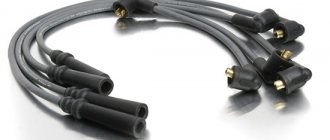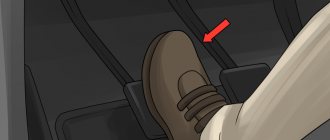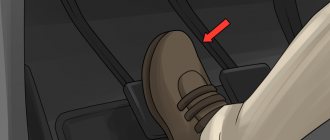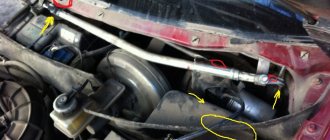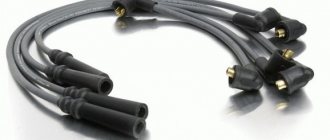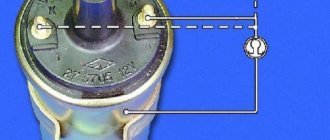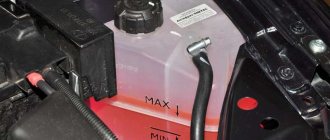When do you need to change armored wires in a car?
The scheduled period for replacing high-voltage wires is indicated in the vehicle operating instructions. Their resource is expressed both in kilometers and in operating time.
The warranty period for armored wires is set at 40 thousand kilometers or 5 years. Their service life is 8 years.
The failure of high-voltage devices can be judged by the following signs:
- the engine does not start well;
- often stalls and jerks when operating at low speeds;
- picks up speed poorly when you press the gas pedal;
- excessive fuel consumption;
- high hydrocarbon content in exhaust gases.
Such symptoms of engine operation can be caused by a break in the electrical circuit in the armored wire or a current leak in it.
Defects in high-voltage wires that require replacement are:
- rupture of the metal contact with the current-carrying conductor;
- core oxidation;
- burnout of the metal contact along with the core;
- insulation damage;
- microcracks on the surface of wires;
- loss of elasticity;
- increase in wire resistance due to contamination;
- breakdown of the noise suppression resistor.
Spark plug life
Trouble-free operation of spark plugs can be quite realistic even over 100,000 km. Although, the real effective service life of these components ranges from 30 to 50 thousand km.
If the spark plugs do not produce an optimal spark, the fuel will not ignite properly. As a result, engine power is lost, interruptions occur and fuel consumption increases.
To avoid the symptoms described above, you must follow simple recommendations:
- Refill only proven and high-quality fuel. This will prevent the appearance of red deposits on the spark plug electrodes.
- It is necessary to establish the optimal gap between the side and central electrodes. If the gap is too small, the spark will be weak and the engine power will be far from maximum. If the gap, on the contrary, is large, interruptions in engine operation will occur, which will lead to constant jerking when moving.
- Only use spark plugs recommended by your vehicle manufacturer. The heat number must be strictly observed.
- Replace strictly according to the regulations of the manufacturer of your machine.
If, even after replacing the spark plugs, interruptions in engine operation remain, then it is necessary to check the high-voltage spark plug wires. They usually last quite a long time and can deteriorate mainly due to mechanical stress. But there are times when they wear out from the inside.
In order to check their functionality, you need to test the wires with a multimeter and find out the resistance value. Typically, the operating instructions for your car indicate the permissible resistance values of the spark plug wires.
If, as a result of the measurements, it turns out that the parameters exceed the permissible values, the high-voltage wires must be replaced with new ones. As for the price of these components, for candles the cost can be from 150 to 1500 rubles, depending on the type and manufacturer. And the price of wires will be approximately two times lower.
Issues discussed in the material:
- Why are high voltage ignition wires needed?
- What are the causes and signs of malfunction of these wires
- How to check high voltage ignition wires
- How to choose the right high-voltage ignition wires
Among all automotive electrics, high-voltage ignition wires, also called spark plug wires, deserve special attention. They are special in that they can withstand high voltage current, protecting other components and mechanisms of the car from it. Any car owner must know how to check high-voltage ignition wires, because any malfunction of the spark plug electrics can lead to the failure of expensive components.
How often should spark plug wires be changed?
Spark plugs provide uninterrupted electricity needed for combustion by igniting atomized fuel in the engine cylinders.
However, for this they need a constant supply of electricity. Automotive spark plugs, plugs, and wires wear out over time. Once they begin to wear out, the electrical charge sent to the spark plugs does not always reach the spark plugs properly, which creates problems with the engine's operation, including rough idling, stalling and other problems.
How Often Should You Change Spark Plug Wires
There is no single rule that governs all vehicles. To begin with, in new cars the wires have already been removed and replaced with new coils, this category of people can sleep peacefully :). But some car brands still can't move away from wires that can last much longer than ever before.
In most cases, the service life of your wires should not exceed 50,000 km, which is what copper spark plugs are designed for. However, there are other factors:
Broken: Possible damage to the spark plug wires. If the insulation is broken or there is an internal break, you need to replace the wires, even if it is not time yet.
Driving over long distances: high performance and especially on uneven surfaces negatively affects the long service life of the wires and the car in general, and some types of high-performance spark plug wires may require relatively frequent replacement (every 50,000 -65,000 km).
Resistance: Perhaps the best way to determine if your spark plug wires need to be replaced is to check their resistance. To do this you will need an ohmmeter and you will need to know what the original resistance of the wires was. Check each wire and look for higher resistance levels than when originally installed, as well as higher resistance in individual wires (indicating a bad wire).
While modern cars do not require regular service checks like carbureted cars, they do require regular maintenance, and if not given proper attention, the spark plugs will eventually fail. Therefore, I recommend looking under the hood of your iron horse more often.

